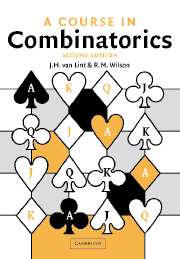Book contents
- Frontmatter
- Contents
- Preface to the first edition
- Preface to the second edition
- 1 Graphs
- 2 Trees
- 3 Colorings of graphs and Ramsey's theorem
- 4 Turán's theorem and extremal graphs
- 5 Systems of distinct representatives
- 6 Dilworth's theorem and extremal set theory
- 7 Flows in networks
- 8 De Bruijn sequences
- 9 Two (0, 1, ⋆) problems: addressing for graphs and a hash-coding scheme
- 10 The principle of inclusion and exclusion; inversion formulae
- 11 Permanents
- 12 The Van der Waerden conjecture
- 13 Elementary counting; Stirling numbers
- 14 Recursions and generating functions
- 15 Partitions
- 16 (0, 1)-Matrices
- 17 Latin squares
- 18 Hadamard matrices, Reed–Muller codes
- 19 Designs
- 20 Codes and designs
- 21 Strongly regular graphs and partial geometries
- 22 Orthogonal Latin squares
- 23 Projective and combinatorial geometries
- 24 Gaussian numbers and q-analogues
- 25 Lattices and Möbius inversion
- 26 Combinatorial designs and projective geometries
- 27 Difference sets and automorphisms
- 28 Difference sets and the group ring
- 29 Codes and symmetric designs
- 30 Association schemes
- 31 (More) algebraic techniques in graph theory
- 32 Graph connectivity
- 33 Planarity and coloring
- 34 Whitney Duality
- 35 Embeddings of graphs on surfaces
- 36 Electrical networks and squared squares
- 37 Pólya theory of counting
- 38 Baranyai's theorem
- Appendix 1 Hints and comments on problems
- Appendix 2 Formal power series
- Name Index
- Subject Index
Preface to the second edition
Published online by Cambridge University Press: 05 June 2012
- Frontmatter
- Contents
- Preface to the first edition
- Preface to the second edition
- 1 Graphs
- 2 Trees
- 3 Colorings of graphs and Ramsey's theorem
- 4 Turán's theorem and extremal graphs
- 5 Systems of distinct representatives
- 6 Dilworth's theorem and extremal set theory
- 7 Flows in networks
- 8 De Bruijn sequences
- 9 Two (0, 1, ⋆) problems: addressing for graphs and a hash-coding scheme
- 10 The principle of inclusion and exclusion; inversion formulae
- 11 Permanents
- 12 The Van der Waerden conjecture
- 13 Elementary counting; Stirling numbers
- 14 Recursions and generating functions
- 15 Partitions
- 16 (0, 1)-Matrices
- 17 Latin squares
- 18 Hadamard matrices, Reed–Muller codes
- 19 Designs
- 20 Codes and designs
- 21 Strongly regular graphs and partial geometries
- 22 Orthogonal Latin squares
- 23 Projective and combinatorial geometries
- 24 Gaussian numbers and q-analogues
- 25 Lattices and Möbius inversion
- 26 Combinatorial designs and projective geometries
- 27 Difference sets and automorphisms
- 28 Difference sets and the group ring
- 29 Codes and symmetric designs
- 30 Association schemes
- 31 (More) algebraic techniques in graph theory
- 32 Graph connectivity
- 33 Planarity and coloring
- 34 Whitney Duality
- 35 Embeddings of graphs on surfaces
- 36 Electrical networks and squared squares
- 37 Pólya theory of counting
- 38 Baranyai's theorem
- Appendix 1 Hints and comments on problems
- Appendix 2 Formal power series
- Name Index
- Subject Index
Summary
The favorable reception of our book and its use for a variety of courses on combinatorial mathematics at numerous colleges and universities has encouraged us to prepare this second edition. We have added new material and have updated references for this version. A number of typographical and other errors have been corrected. We had to change “this century” to “the last century” in several places.
The new material has, for the most part, been inserted into the chapters with the same titles as in the first edition. An exception is that the material of the later chapters on graph theory has been reorganized into four chapters rather than two. The added material includes, for example, discussion of the Lovàsz sieve, associative block designs, and list colorings of graphs.
Many new problems have been added, and we hope that this last change, in particular, will increase the value of the book as a text. We have decided not to attempt to indicate in the book the level of difficulty of the various problems, but remark again that this can vary greatly. The difficulty will often depend on the experience and background of the reader, and an instructor will need to decide which exercises are appropriate for his or her students. We like the idea of stating problems at the point in the text where they are most relevant, but have also added some problems at the end of the chapters. It is not true that the problems appearing later are necessarily more difficult than those at the beginning of a chapter.
- Type
- Chapter
- Information
- A Course in Combinatorics , pp. xiii - xivPublisher: Cambridge University PressPrint publication year: 2001

